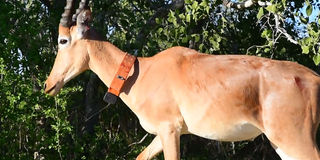Garissa conservancy puts GPS collars on endangered hirola antelope

One of the collared hirola antelope.
Ishaqbini Hirola Community Conservancy in Garissa County has offered a major boost to conservation efforts of the endangered Hirola antelope by collaring the animals for easier monitoring.
Five critically endangered Hirola antelopes have been fitted with GPS-enabled collars which will transmit information to the sanctuary’s management team twice a day. This will also enable rangers to remotely monitor the animals before their release into a free range area safe from predators.
The rangers will, after the release, continue monitoring their interaction with other wildlife and the information is expected to assist in securing the endangered species.
The four-day exercise by the conservancy, in partnership with the Kenya Wildlife Service and the Northern Rangelands Trust (NRT), comes as a huge milestone for the community-run project that seeks to conserve the world’s most endangered antelope.
Hirola, tan brown in colour and with long sharp horns, has the smallest known number of antelope species (less than 500 in the world) and is the only surviving member of genius Beatragus with the highest numbers being in Kenya’s Ijara in Garissa County.
Monitor their movement
The collaring was done at the request of the Ishaqbini Hirola Community Conservancy board to KWS. The board is seeking to monitor their movement patterns within the sanctuary and at Ishaqbini Community Conservancy once they are released from the sanctuary.
The sanctuary, established in 2012, started off with 48 Hirola and their population has grown by 160 per cent in last eight years with the numbers ranging between 118 and 130 animals in December 2019, which translates to about 20 to 25 per cent of the global population.
Disease surveillance and management has been ongoing in the conservancy to prevent potential outbreaks of illnesses that have in the past threatened the existence of the antelope.
The growth has resulted in increased pressure on the resources within the sanctuary, leading to reduced forage and fierce competition between Hirola males, thereby reducing their breeding chances.
“After successful breeding of the Hirola, the sanctuary is reaching its carrying capacity and there is now a need to release male herds out of the sanctuary into the larger Ishaqbini Conservancy,” said Mr Ahmed Noor, the conservancy manager.
The Hirola, which can weigh up to 110 kilogrammes, has suffered suppressed population growth over the past 40 years due to disease, competition over rangelands, poaching and predation, with the estimated world population being 450 animals.
KWS senior scientist in the eastern conservation area Geoffrey Bundotich said the collaring will help officers monitor real time ranging patterns of the Hirola once they are released to the expanded sanctuary.
Ensure sustained growth
“We will continue to work with the local communities and other partners to ensure a sustained Hirola growth through the sanctuary expansion,” the KWS scientist said.
An ongoing vaccination exercise supported by San Diego Zoo Global will vaccinate over 50,000 head of livestock, including sheep, goats and cattle, against viruses and bacteria infections. Last year, over 60,000 head of livestock were vaccinated.
NRT veterinarian Stephen Chege said the NGO is working with the community and the Garissa county government in vaccinating livestock so as to prevent cross-infection of diseases.
“This is very vital in mitigating the potential risk of an outbreak and death of animals which are sources of livelihoods for the pastoralist communities,” said Dr Chege.
He added: “Over 40 years ago there was an estimated 15,000 Hirola population. However, a rinderpest outbreak resulted in mass deaths of domestic and wildlife and, in turn, the loss of over 80 per cent of the species.”
Apart from hosting a thriving population of the world’s most endangered antelope, Ishaqbini Hirola Community Conservancy is home to a variety of other species, among them the gerenuk, ostrich, lesser kudu and the reticulated giraffe.





